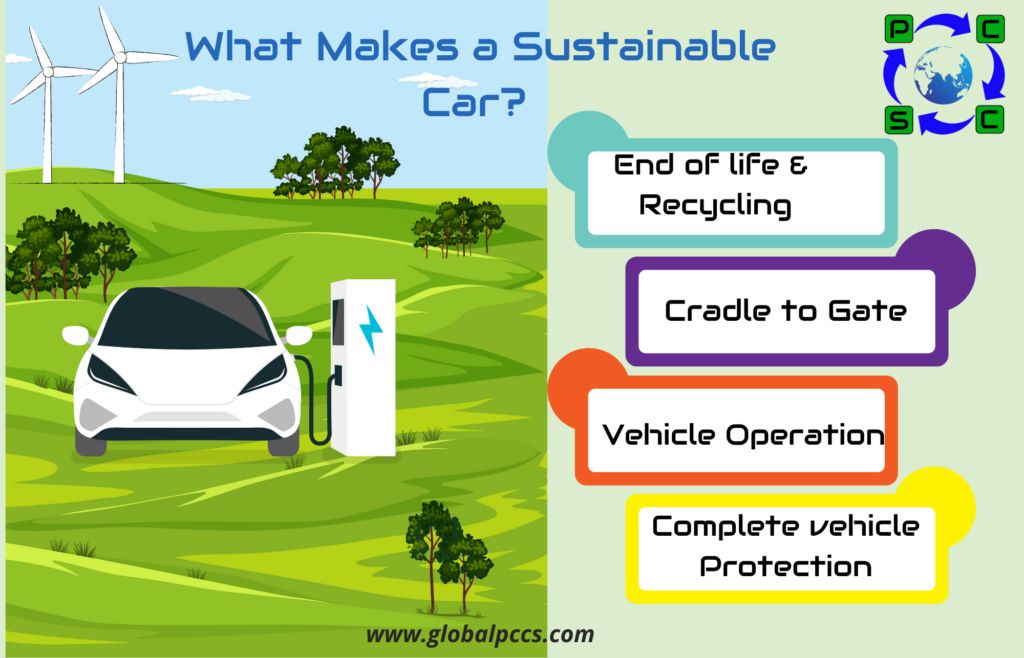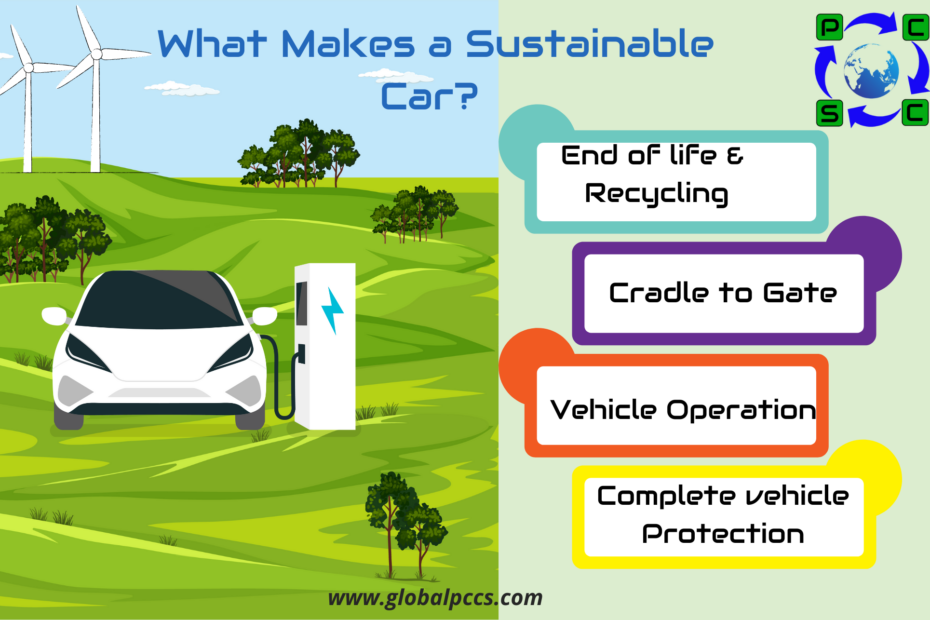
Abstract:
● There is no industry in any major market where sustainability has not become a top priority among manufacturers.
● Especially for the automotive industry, sustainability becomes more and more important due to corporate scandals in the past and topics such as electric motors, lightweight construction and CO2 emission reduction are key issues.
● Established vehicle manufacturers as well as new entrants have kicked off extensive restructuring efforts of achieving (almost) net-zero emissions and making the green future a reality.
● Sustainability is a highly complex aspect of vehicle planning, and it requires interdisciplinary knowledge and considerable efforts if automotive manufacturers intend to properly integrate it into their business strategy.
Sustainability in the Automotive Industry:
● Long-term success in the automotive industry is primarily achieved through consistent innovation strategies, strong branding, global efficiency in the value chain and qualified
and motivated employees.
● Trends such as emission reduction, lightweight construction, automated driving, connectivity, and mobility services have changed the landscape for good.
● The topic of sustainability in the automotive industry is also gaining more momentum in the scientific community.
● Ecological (e.g., CO2 emissions), social (e.g., supplier screening) and economic (e.g., operating costs) aspects are considered as performance indicators of a sustainable business model for the automotive industry that are considered as three dimensions of sustainability.
Key figures regarding automotive industry emissions
● The automotive industry is one of the largest and most important industries worldwide.
● Over 80 million vehicles have been produced which contributes to about 1 Gt (Gigaton) of total 49 Gt greenhouse gas (GHG) emissions annually, around 2% of all global GHG
emissions.
● In recent years, there has been an increased focus on the heat/electricity segment, where most indirect GHG emissions caused by the vehicle’s manufacturing and
automotive supply chain are included.
● GHG emissions are caused by material production upstream activities and, to a lesser extent, vehicle manufacturing processes.
● The automotive industry has started reducing its emissions from complete vehicle manufacturing in recent years. Since 2006, the total emissions from cars produced in Europe have been reduced by around 46%.
SENSIBLE ECODESIGN: THE FOUNDATION OF EVERY SUSTAINABLE CAR STRATEGY
If vehicle manufacturers want to reduce their carbon footprint, the most effective way to do so is to focus on sustainable design (or eco-design) from the drawing board onwards. Three central pillars make up sensible automotive eco-design.
Pillar #1: How can the resources needed to build the vehicle be reduced?
● The efficient way to reduce the emissions from vehicle production activities is still to keep the resource demands of the vehicle itself as low as possible.
● The term dematerialization covers all measures aimed at delivering the same or even higher level of product quality while decreasing the number of resources needed to do so.
● Reducing scrap rates and optimizing product design for high material utilization are two main drivers for that.
● The term “resources” in this sense is not restricted to raw material, but also includes the energy needed to produce the car and its components as well as the material needed to operate and maintain the car (primarily fuel/electric energy).
Reducing resources also means reducing the weight of the vehicle which by itself also has positive effects on its fuel/energy consumption rate and reduces how often the end users need to refuel or recharge their vehicles.
Pillar #2: How can waste and pollutants be avoided?
The production and use of a vehicle, even under the most optimal conditions, will produce some emissions somewhere in the vehicle’s life.
Emissions are often associated with GHG emissions, other pollutants are also produced, ranging from volatile organic compounds and nitrogen dioxide to rubber particles and packaging waste accumulated during production.
One issue is the concentration of hazardous pollutants that could potentially harm the vehicle user directly.
To make a sustainable vehicle, the amount of waste should be reduced wherever possible, while harmful substances should be avoided entirely.
For example, some vehicle manufacturers have started to use water-based lacquers instead of the common solvent-based lacquers.
These water-based lacquers are not hazardous, thus preventing any harm to the health of painters in the manufacturing plant as well as recyclers at the vehicle’s end of life.
Eco-design also focuses on increasing vehicle interior air quality by avoiding the accumulation of harmful substances inside the vehicle.
1. With the application of well-balanced air-recirculation modes in the vehicle cabin and the selection of appropriate cabin filters, such as HEPA filters with activated carbon
layers.
2. Selecting low emission material for the interior compartment also decreases pollutant concentration inside the vehicle.
Pillar #3: How can primary resources be substituted?
● As recycling grows more and more relevant in the industry, many automotive engineers now also consider selecting more secondary material in their development strategies
by increasing the percentage of recycled materials used for their vehicles.
● Raw materials can be replaced by more environmentally friendly alternatives entirely, if possible.
● For example, in recent years, aluminum has been increasingly used to replace steel in car bodies, given its significantly lower weight and higher feasibility to extensively
increase the amount of secondary material with it.
● This results in beneficial effects on both raw material processing and use phase energy demands.
SUSTAINABILITY IN AUTOMOTIVE: THE LIFE CYCLE OF A GREEN CAR
The four stages of every vehicle’s life cycle:
Stage #1: Material & component design & production (Cradle-to-Gate)
● The cradle-to-gate stage covers all steps required to produce the individual components of the car.
● Producing materials like glass, steel and aluminum, welding body parts, producing chemical precursors and compounding polymers, vulcanizing rubber, semiconductors,
microchips and so on – building a car requires a lot of resources, skills, and energy.
● Consequently, this stage covers a significant percentage of the emissions created during the automotive life cycle.
● To reduce emissions, raw material can be substituted with secondary resources or eco-friendlier alternatives.
● The location of the supplier plays a particularly important role regarding geographical proximity.
● Carmakers should choose local suppliers in countries with a high renewable energy share and strict environmental standards if they want to lower their material and component related GHG emissions and improve overall sustainability performance.
Stage #2: Complete Vehicle Production
● This stage covers the bodyworks, painting, and assembly of individual components into the final vehicle as well as inbound and outbound transport.
● It is during this phase where vehicle manufacturers can implement sustainability measures most efficiently, given that vehicle production is their core business and all
emissions caused during it are under their full control.
● Methods to reduce waste and energy consumption make up a comparatively small percentage of the total vehicle life cycle GHG emissions.
● But at the same time, manufacturers can directly implement measures in their manufacturing sites and achieve net-zero GHG emissions in this area.
Stage #3: Vehicle Operation/use phase
● This stage covers the vehicle operation by the end customer, including maintenance efforts.
● The assumed vehicle lifetime in life cycle assessments (LCA) for average EU vehicles is about 10 years with a mileage of 200,000 km which correlates to a significant portion of
total car emissions.
● EVs perform much better in terms of use phase-emissions, potentially creating close to zero emissions, save for non-avoidable emissions, however, achieving this value
requires several beneficial factors.
● In countries with little renewable energy production, even the most efficient battery electric vehicle will cause notable emissions.
● The work of the engineering team and how they can implement the three pillars of sensible eco-design is very important, i.e., to improve efficiency and durability of the complete vehicle.
● They need to make sure that the vehicle can operate for as long as possible, uses as little energy as possible, all while remaining affordable in both purchase and maintenance.
Stage #4: End of Life (EoL)/recycling
● In the final stage of the vehicle’s life cycle, the main challenge is how the EoL vehicle, and its materials can be returned into a subsequent new vehicle life cycle.
● Vehicle manufacturers have long since begun to pay more attention to what should happen to the discarded vehicles and how the raw materials of the car, which are rare
and produced at great expense, can be further used.
● Eco-design considers that individual components containing critical raw materials for the automotive industry can be easily separated from one another to avoid incompatibilities and other problems for future material recycling.
● To reduce high efforts and energy demand for recycling EoL vehicles, manufacturers need to implement a vehicle concept that is dismantling-friendly and compatible with
recycling methods.
● It is also important to find suitable partners for collecting, processing, separating, and re-using target components of the EoL vehicle, followed by state-of-the-art recycling
and material recovery methods.
● Raw materials that can no longer be returned to vehicle parts production should be recycled in other industries.
BURDEN SHIFTING: THE GREATEST CHALLENGE OF SUSTAINABILITY STRATEGIES
A good sustainability strategy requires the appropriate level of expertise and planning to avoid what we at Magna call “burden shifting”.
● Burden shifting means that implementing measures to lower emissions in one stage of the vehicle life cycle could cause negative effects in another stage, instead of reducing
net GHG emissions, they are simply shifted elsewhere.
● The electrification currently happening in the complete land transportation sector is a good thing environment-wise.
● EVs produce virtually no emissions during their use phase compared to approx. 116g CO2/km emitted by the average European vehicle.
● The electric vehicle’s production depends on a significantly higher number of special metals (like Lithium, Nickel, Cobalt, or Manganese) and rare earth elements, whose
excavation causes notably higher GHG emissions.
● Also, producing the electricity needed for charging EVs could cause high GHG emissions, if generated by power plants based on fossil resources, i.e., natural gas, oil, and coal.
Avoid burden shifting by developing a holistic view on sustainability!
● There are other smaller factors that can also cause negative burden shifting. For example, an assembly concept may not consider that EV batteries are a complex
system by themselves and that they demand a fitting recycling concept.
● In practice, many of the special metals used for Lithium-ion batteries and rare earth elements used in EVs’ drivetrains are still insufficiently recycled, partly because their complex layout makes it difficult to extract the individual components.
● Carmakers need to make conscious decisions about which resources they implement, which suppliers they cooperate with, and how each feature-related decision affects the GHG emission results and recyclability of the final product.
Conclusion
The automotive industry is a prime example of small steps bringing change and contributing to a more environmentally friendly world.
The engineering and design team behind an automotive project can make a huge difference in the environmental impact of the vehicle, as the product’s carbon footprint is influenced by every activity from the first sketches to the start of production.








 Authorised IMDS & CDX Training & Consulting partner for
Authorised IMDS & CDX Training & Consulting partner for






